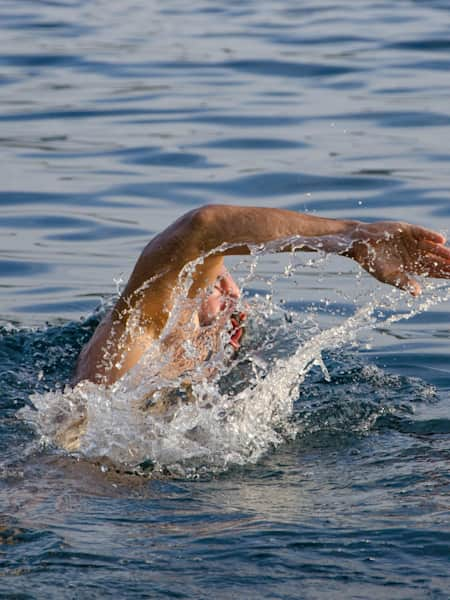Swimming isn’t all about the wet stuff. To get better in the water, you need to work on building strength and conditioning to give you a stronger core to help you when swimming. Not least in open water when the elements and tides often pushes your body to its limits.
So then, ahead of Red Bull’s Neptune Steps in Glasgow on 23 March – where competitors will not only swim down a canal but climb over gates – we want to give you a gym routine like no other.
Devised by Fred Vergnoux, Speedo and head coach, and strength and conditioning coach Fernando Zarzosa, these are exercises you should perform one to three times per week, changing, adding or reducing sets and repetitions where you see fit. “Focus your energy in each repetition, and always look for speed in your movement,” says Vergnoux, who takes us through it below...
1. Russian Twists
“Body rotation is fundamental to open water swimming,” says Vergnoux. “It helps create a more efficient stroke, by gliding more on each stroke and using less energy during a race.”
Swimmers should do Russian twists. Sitting down with both legs raised in the air, twist your hips while holding a medicine ball or weights. Extend as much as you can to really feel the benefits. Try 8 sets of 18 repetitions, or work with time - 6 x 20 seconds, for example.
2. Weighted push-ups
“The pectoral and tricep muscles are heavily involved in swimming, and in open water they must be well prepared,” says Vergnoux. “In the gym, swimmers should train those muscles a couple of times per week.
Using the bench press allows you to build strong pectoral muscles, which results in a good catch in the water and also helps to maintain a good distance per stroke. It also works the triceps, which helps you to finish each stroke with power and acceleration. The triceps are also important for a long reach in order to not reduce the distance per stroke.
"Swimmers should practise push-ups as many times as they can during the week. It is a simple but effective exercise to maintain general fitness, work the resistance of the triceps and pectorals, and it also involves the core muscles. The 10x10 push-up challenge is hard, but it’s amazing to achieve 100 push-ups a couple of times per week. With the bench press, we strongly recommend performing 6 sets x 10 repetitions, increasing additional weight slowly."
3. Planking
Simple but effective, as well as building strength in the core, planking can help maintain a good body position in the water. Get into the push-up position, bending your elbows and resting your weight on your forearms. Now ensure that your body is in a straight line, all the way from your shoulders to your ankles. Engage your core to ensure your back does not arch and hold this position for as long as you can, before resting and going again.
“Remember that breathing with your head up while swimming will put pressure on your lumbar zone, and doing the plank on a regular basis will help you with this,” says Vergnoux. Try 6 sets of 8 seconds and gradually build towards more.
4. Skipping
“Kicking is a very important aspect to work on while preparing for open water events. Swimmers should have strong legs not only for fitness, but also because it helps the swimmers to maintain a good body position. This allows you to accelerate when the race gets going and, more importantly in open water, allows you to take a breath by lifting your head up.”
Believe it or not, rope skipping, a great tool for general fitness and a great gym warm up routine, is excellent to do prior to a swim race. The legs will get stronger from bursts of 60 to 90 seconds a time, so try those, jumping on the balls of your feet, avoiding swinging your arms too much and never jumping too high. "You need to find a rhythm," says Vergnoux.
5. Mountain climbers
Another way to help with explosive leg work is performing mountain climbers. More specific to swimming, they not only work your leg resistance but improve your general swim position, too. “Your arms and shoulders are involved, the core is working hard and the whole body is active like it would be while swimming,” says Vergnoux. “Try 60 seconds of skipping, followed by 30 climbers, doing 4 to 8 sets."
6. Bench pulling
“Swimmers use their arms as the main method of propulsion,” says Vergnoux. “The main focus in open water should be distance per stroke and building speed, which must be trained on a regular basis in the gym. Resistance work can help, and using the ‘classic’ pull-ups, and reverse bench drill can be very effective.”
The barbell bench pull in particular is a very useful exercise to do in the gym because it isolates the lats, which are the muscles that fatigue in open water racing. The horizontal position is also more specific to swimming. Do 6 sets of 8 to 12 repetitions with the reverse bench.
A great challenge to improve arm strength is to do your age in pull-ups. If you are 25 years old, for example, try to do 25 pull-ups in total during your training session. Depending on your level of fitness this can be achieved in sets of 5 to 8 repetitions.




